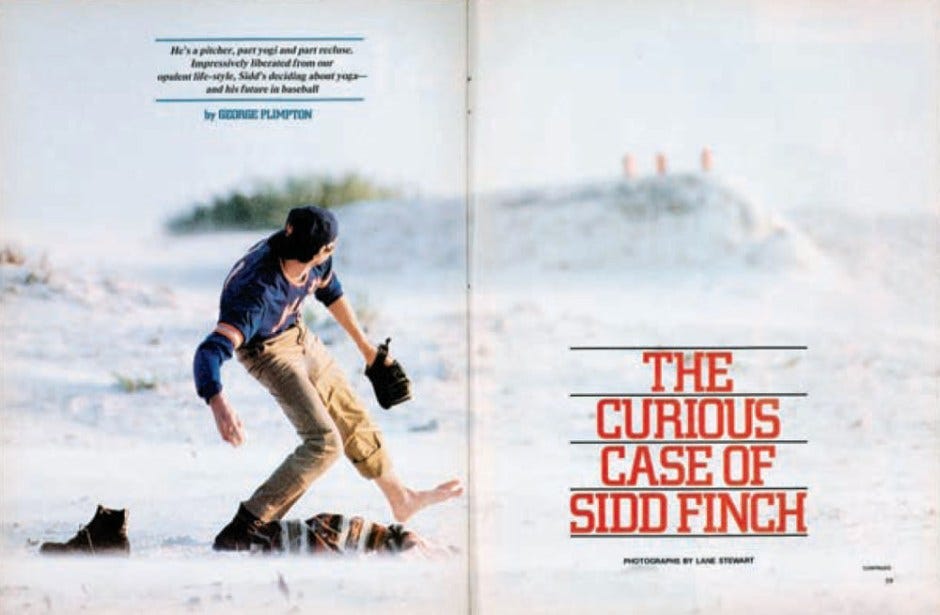Sports Illustrated Strikes Out (Another Update)
Here at History, Rinse, & Repeat, we continue to take advantage of the Christmas holiday to rest and recover from our inaugural year of blogging and to publish brief updates of prior articles rather than original ones. Christmas can bring stockings full of cheer or stockings full of coal.
The coal in this year’s Christmas season concerns the demise of a once great magazine, Sports Illustrated, which has been the subject of two articles on this site, Sports Illustrated and the Politics of The Pin-Up and Sports Illustrated and the Politics of The Pin-Up -- El Tri Meets The Rainbow (Update).
Just last month, the magazine that once boasted articles by famed authors such as William Faulkner, John Steinbeck, Robert Frost, and John Updike was credibly accused of using Artificial Intelligence to write stories under the bylines of fictitious authors. Among the so-called authors was purported fitness guru “Sora Tanaka,” who “has always been a fitness guru,” and who was “thrilled to bring her fitness and nutritional expertise to the Product Reviews Team, and promises to bring you nothing but the best of the best.” Ms. Tanaka apparently does not exist, making her Sports Illustrated’s greatest hoax since Sidd Finch, the 1985 prospect for the New York Mets who played the French horn, wore a hiking shoe on the mound, threw an unthinkable 168-mph fastball, and who was invented by George Plimpton as the magazine’s April Fool’s prank.
As a result of the accusations (or merely by coincidence), the publication’s chief executive officer, chief operating officer, and chief legal officer were all fired in order “to improve the operational efficiency and revenue of the company.” Unfortunately, these firings have done nothing to improve the quality of Sports Illustrated’s articles. Once the pre-eminent magazine governing sports, the publication has embraced political activism to such a degree that it no longer even pretends to cover sports.
For many die-hard soccer fans, among them this author, the Champions League, a competition that matches the top club teams in Europe, is, to a large degree, the apogee of the sport. To be sure, nothing can match the World Cup for pageantry and national fervor. But, if the World Cup presents the best players from all over the world in one tournament, the Champions League presents the best of those best. As an example, only a handful of players from Argentina’s champion-winning squad currently play for a Champions League team. The caliber of the players, and the level of play, is unmatched.
The competition is divided into two stages: the group stage, where eight groups of four teams play each other, and the knockout rounds, where the top two teams from each group play a series of home and away elimination matches until only the winner is left. For some small teams, such as F.C. Copenhagen (my family’s hometown team), making the round of sixteen was an achievement in itself. For more renowned teams, such as Paris St. Germain, which only staggered into the group stage, making the knockout round was the bare minimum. For other European giants, such as Manchester United, to be eliminated at the group stage was a calamity.
Last week was the final week of the group stage, the last chance for teams to secure their spot in the knockout round. There were dramatic stories galore, including F.C. Copenhagen’s historic upset. The most dramatic came from the “group of death,” so-called because it included by luck of the draw -- good or bad -- four giants of European soccer. Depending upon the results of that final day, all four teams had a chance to qualify. As the games progressed, and the scorelines ebbed and flowed, the position of each team in the standings repeatedly changed. Every shot that hit the post, or every shot which the goalie miraculously saved meant the difference between advancing in the competition and going home. For 59 minutes, PSG was third in the group and going home. The late goal they scored, and the one Newcastle conceded, turned the table on its head, and meant PSG would advance and Newcastle, instead of advancing, would finish last. At the end of the day, fans’ emotions ran the gamut, from ecstasy (F.C. Copenhagen) to despair (Manchester United), to pure relief (PSG).
How did Sports Illustrated cover this important and dramatic day in world soccer? It didn’t. What insights or analysis did it supply into the final day of matches, or into the potential matchups of the sixteen teams that survived? None. Remarkably for a magazine purportedly about sports, it did not devote a single word to the Champions League, as the screenshot of its soccer page reflects.
What did the magazine deem more important? The level of online abuse directed at the US Women’s National Team months ago during the Women’s World Cup, a documentary appearing on Netflix about that team, and, of course, a tribute to Megan Rapinoe. It is as if a magazine that purports to cover baseball simply omitted coverage of the World Series in order to cover misogyny in women’s softball.
Where once readers went to Sports Illustrated to read intelligent analysis of the prior week’s sporting events, now they cannot even find the score. To say that this husk of a magazine is beyond parody is not to employ a rhetorical device. It is a simple statement of fact. There is simply no reason to pay for the privilege of reading it anymore, particularly as paid subscribers are required to turn off their adblocker and endure advertisements when reading it online.
For readers of this site, however, there is one silver lining. They will no longer be subjected to articles about the magazine. The reason? I am finally cancelling my decades-long subscription.






